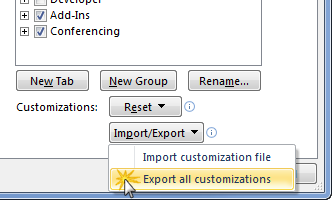Backing up Ribbon customizations
After making several changes to the Ribbons and Quick Access Toolbars in Outlook, I wanted to make a backup of my customizations. There is an export button for this in the Options dialog but this only backs up the customizations for the current item window and not all the item windows which are available in Outlook. This makes the exporting process quite cumbersome.
Is there a way to backup all the Ribbon customizations at once?
After making several changes to the Ribbons and Quick Access Toolbars in Outlook, I wanted to make a backup of my customizations. There is an export button for this in the Options dialog but this only backs up the customizations for the current item window and not all the item windows which are available in Outlook. This makes the exporting process quite cumbersome.
Is there a way to backup all the Ribbon customizations at once?
The way to backup all your Ribbon and Quick Access Toolbar (QAT) customizations in Outlook 2010 in one go is similar to backing up the QAT customizations in Outlook 2007.
The Ribbon and QAT settings in Outlook 2010 are stored in officeUI-files in the following folder;
Windows 7 and Windows Vista
C:\Users\%username%\AppData\Local\Microsoft\Office
Windows XP
C:\Documents and Settings\%username%\Local Settings\Application Data\Microsoft\Office
You should be able to migrate these files between machines by simply copying the files from one machine to the other. Any command that you have placed in the Ribbon or QAT which isn’t available on the other machine (such as a function of an add-in or custom VBA code) will be removed automatically.
There are up to 20 officeUI-files possible for Outlook 2010. If you haven’t modified the Ribbon or the QAT for the corresponding item window, there won’t be an officeUI-file for it either. Below you’ll find an overview of the officeUI files and their corresponding item window.
| File name | Item Window |
| olkexplorer.officeUI | Main Outlook window |
| olkmailitem.officeUI | Composing a Message |
| olkmailread.officeUI | Opened Message |
| olkpostitem.officeUI | Composing a Post |
| olkpostread.officeUI | Opened a Post |
| olkappitem.officeUI | Appointment or Meeting Request |
| olkaddritem.officeUI | Contact item |
| olkdlstitem.officeUI | Distribution list item |
| olktaskitem.officeUI | Task or Task Request item |
| olklogitem.officeUI | Journal entry |
| olkrssite.officeUI | Opened RSS item |
| olkshareitem.officeUI | Composing a Sharing Invitation |
| olkshareread.officeUI | Opened Sharing Invitation |
| olkreportitem.officeUI | Opened Receipt (delivery notification, read notification, vote answer, accepted meeting request, accepted task request) |
| olkmreqread.officeUI | Opened Meeting Request, Task Request or Cancellation |
| olkrespondseread.officeUI | Opened Meeting Request responds item (accepted, declined, tentative) |
| olkrespcounter.officeUI | Opened new proposal responds item for a Meeting Request |
| olkrespondsesend.officeUI | Composing a responds for a Meeting Request (accept, decline, tentative, new proposal) |
| olkreqsend.officeUI | Composing a forwarded Meeting Request |
| olkresenditem.officeUI | Composing a Send Again message (for failed messages) |
Note: The mentioned folder location is hidden by default. You can copy and paste the above location in the Address Bar of Windows Explorer to open it or configure Windows to show hidden files and folders; Control Panel-> Folder Options-> tab View

Exporting Outlook customizations manually is quite cumbersome
for the many Outlook windows.

